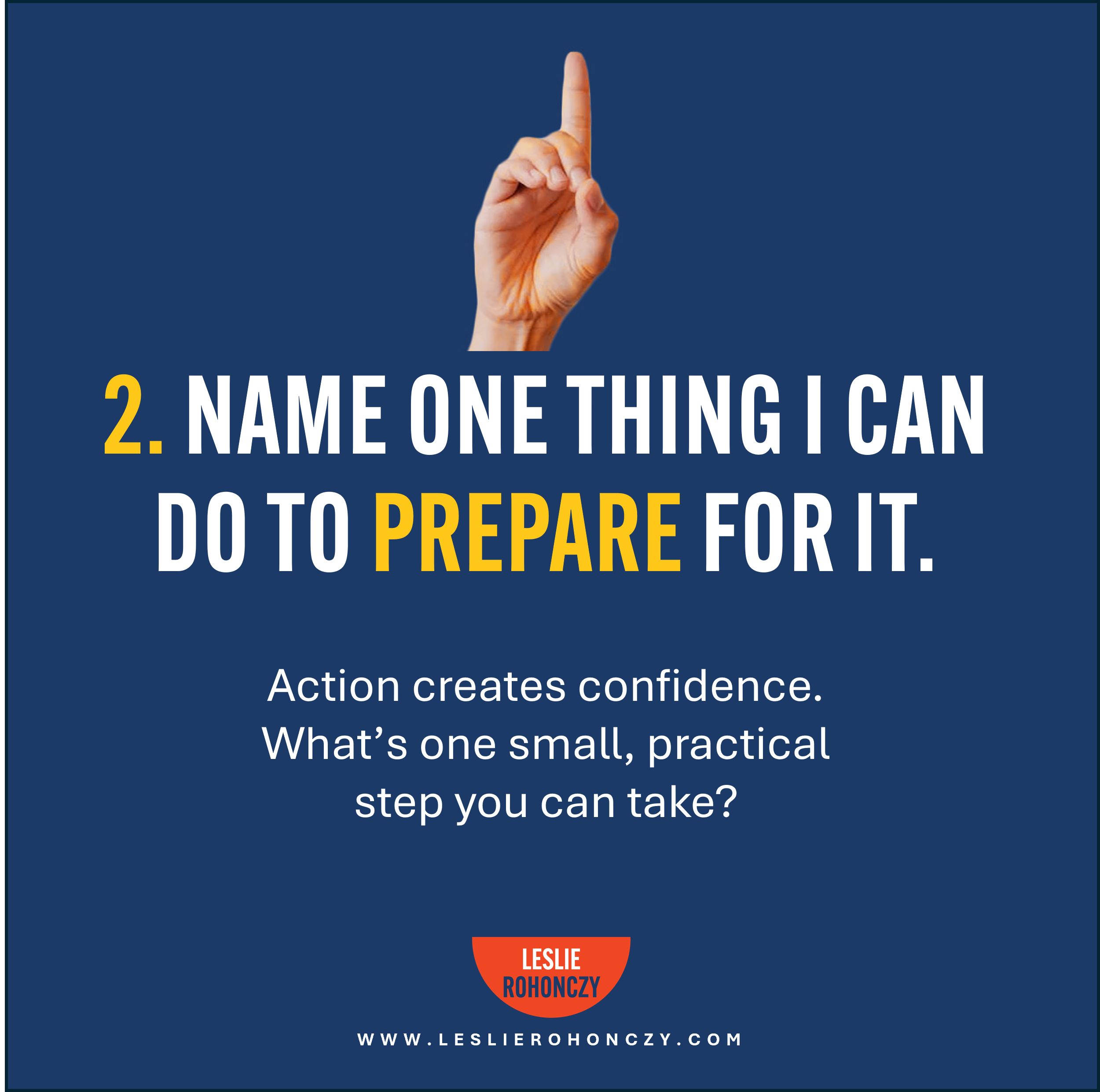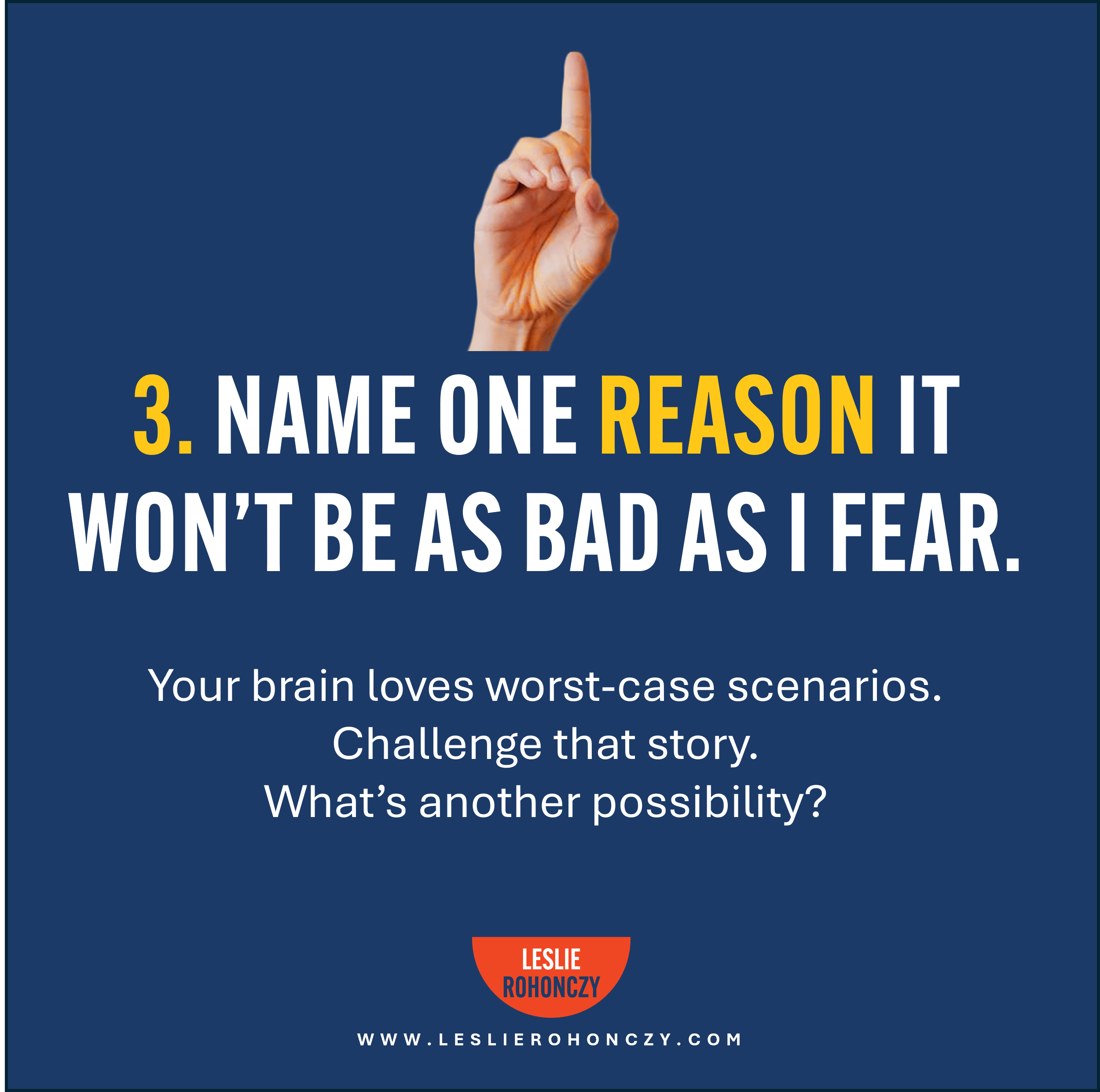Leslie Rohonczy, IMC™, PCC, Executive Coach, Leadership Expert, Speaker, Author
If you’ve been feeling overwhelmed lately (and let’s be honest – who isn’t these days), you’re not alone. The world feels like a pressure cooker on the verge of exploding, and even the strongest among us are feeling the heat. Unprecedented levels of uncertainty, political upheaval, economic instability, and global tensions can make even the most resilient leaders feel anxious. But here’s the thing: anxiety thrives in ambiguity. When everything feels out of control, our minds spin stories of worst-case scenarios, feeding a cycle of stress that can feel impossible to escape.
The good news? You don’t have to tackle everything at once. Research shows that our brains can only process a limited amount of information at a time. This is known as cognitive load. When we try to manage everything at once, decision fatigue sets in, making it harder to think clearly or take effective action. By focusing on just one thing at a time, we can reduce mental overwhelm and make it easier to regain control. Instead, you can break it down into something much more manageable; just one thing at a time.
This exercise, which I call the One Thing Practice is like a mental reset button, giving you a chance to pause, assess, and shift your mindset before stress takes the wheel. By answering six simple questions, you’ll create a sense of clarity and control, even in turbulent times. Let’s walk through them together.
1. Name the thing I’m anxious about.
When stress hits, our minds tend to generalize: “Everything is a mess.” “Nothing is going right.” “The world is falling apart.”
But what exactly is causing your anxiety? Naming it is the first step in reclaiming control. Instead of saying, “I’m stressed about the state of the world,” get specific: “I’m worried that the financial downturn will impact my job security.” Or “I’m anxious about how a new policy change will affect my business.”
Once you’ve named it, you’ll notice that your stress becomes something you can begin to examine and explore, rather than experiencing it as an overwhelming cloud of fear.
2. Name one thing I can do to prepare for it.
Now that you’ve identified the source of your anxiety, it’s time to shift into action. What’s one small, concrete step you can take to feel more prepared?
If you’re worried about job security, can you update your resume? Strengthen your network? If economic uncertainty is affecting your business, can you revisit your budget or explore ways to diversify revenue streams?
The message here is that action reduces anxiety (though it doesn’t eliminate it entirely; some anxiety is natural.) Even the smallest step forward reminds you that you are not powerless.
3. Name one reason that it won’t be as bad as I fear.
Our brains are wired to anticipate worst-case scenarios, but reality is rarely as catastrophic as we imagine. Consider this: how many times have you worried about something that never actually happened?
Let’s say you’re worried about an upcoming presentation you have to make to the Board. Your brain is already crafting the script for a horror film: the lights come up, your mind goes blank, and the audience stares in awkward silence as you struggle to remember even one of your key messages. Harsh judgment is revealed on the faces of the Board members and your boss, as they roll their eyes and shake their heads in disappointment. Roll credits.
Your mind might be telling you: “I’ll freeze, forget everything, and embarrass myself.” But in reality, you’ve prepared, you’ve done this before, and even if you stumble, people are usually far more forgiving than we assume.
Challenge your fear with logic. Ask yourself: What’s another possible outcome that’s not worst-case?
4. Name one reason I know I can handle it.
This is where you tap into your resilience. You’ve faced challenges before. You have overcome obstacles. You have proof that you are capable, even when things get tough.
Think about a past situation where you faced uncertainty and made it through. Maybe you successfully navigated a career change, managed a crisis, or led your team through a tough period. You are stronger than you think. And you already have experience proving it.
If it helps to look at others’ experiences and approaches to resilience, think about some of the real Canadians whose examples shine a light on the path forward. Leaders like Arlene Dickinson, who built a multi-million-dollar marketing empire despite early financial struggles, proving that resilience and reinvention go hand in hand. Or Terry Fox, whose determination to run across Canada despite losing a leg to cancer inspired a global movement in cancer research. Or Clara Hughes, who transformed personal struggles with mental health into advocacy, using her platform to champion resilience and well-being. Just like them, you have faced challenges, adapted, grown stronger, and inspired others with your resilience. Your past experiences are proof that you can handle this too.
5. Name one upside to the situation.
Even in difficult times, there is always a silver lining—though sometimes you might need to squint to see it. Finding an upside doesn’t mean pretending everything is great, however. It’s about recognizing that even tough situations can lead to unexpected benefits. Maybe this challenge forces you to develop a new skill, strengthen relationships, or rethink outdated strategies that no longer serve you. What is one possible positive outcome of this situation?
A challenging economic climate might push you to be more innovative. A leadership struggle could highlight opportunities for growth. Even personal setbacks often lead to greater self-awareness and resilience.
This doesn’t mean dismissing the difficulty – it means acknowledging that opportunities often come disguised as obstacles. To help uncover the upside, ask yourself: What new skills or strengths might I develop as a result of this challenge? How might this experience shift my priorities for the better? What doors could this situation open that I wouldn’t have considered before? If I look back on this a year from now, what might I appreciate about what I learned or how I grew?
6. Name one thing I’m grateful for because of it.
Gratitude is one of the most powerful tools for shifting perspective, especially when stress tries to convince us that everything is negative. Instead of focusing on what’s lost or uncertain, gratitude helps us anchor to what remains steady and meaningful. It might be the support of a close friend, the lessons gained from a tough experience, or even the personal growth that comes from pushing through adversity. Even in stressful situations, there is something to be grateful for. This doesn’t mean ignoring or downplaying the difficulty of what you’re facing. Instead, it’s about finding balance—acknowledging the challenges while also recognizing the positives that exist alongside them. What is it?
Maybe this challenge is forcing you to slow down and focus on what truly matters. Maybe it’s revealing who your real support system is. Maybe it’s teaching you something invaluable about yourself and your ‘wiring’.
Speaking of wiring, did you know that gratitude rewires stress? When we consciously shift our focus to what we appreciate, we break the cycle of fear and reframe our experience.
Putting It All Together
This practice is simple, but don’t underestimate its power. In just a few minutes, you can shift from feeling overwhelmed to feeling focused and in control. The next time anxiety creeps in, pause and walk yourself through these six questions. Write them down. Reflect on your answers. Notice how your mindset changes.
One thought at a time. One step at a time. No need for superhero-level resilience, just a willingness to take the next right step. Practicing these six questions consistently helps build long-term resilience, training your brain to approach stress with clarity instead of panic. Over time, you’ll find that shifting your perspective becomes second nature, making you more adaptable and confident in the face of uncertainty. And with this new awareness, you stand at a new vantage point, from which you can take a step in any direction, toward more anchored choices. That’s all it takes to move forward.
If this practice resonates with you, I encourage you to share it with someone who might need it today. The world needs more calm, clear-headed leaders right now, and that can start with you.
Interested in more leadership and mindset strategies? Subscribe to my blog or reach out to explore executive coaching and leadership development opportunities tailored to your needs.









